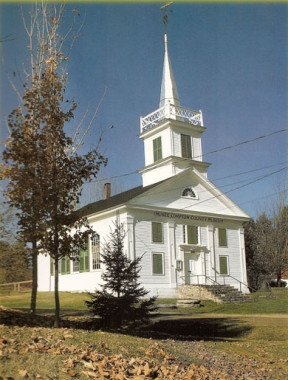Compton County Museum church

Greek Revival architecture:
This style became popular in New England in the 1820s, often influencing the style of religious and institutional buildings. Pediments, friezes and pilasters were blended with the features of traditional colonial houses to create new styles. Usually, homes built in this style have the main entrance set to one side at the gable end, flanked by windows. Compton County Museum consists of two historic buildings -- the former church pictured here, and the old academy across the street. The church was built in 1841 as a Congregationalist Church, and was used by various groups over he years -- most recently the United Church of Canada. It was deconsecrated in the 1950s, and, in 1959 was bought by the Compton County Historical Society for one dollar. It then became the home of the Compton County Museum. The building is an exceptional example of religious architecture in the Greek Revival style. Note the wood construction, the pilasters with heart motifs, which
This style became popular in New England in the 1820s, often influencing the style of religious and institutional buildings. Pediments, friezes and pilasters were blended with the features of traditional colonial houses to create new styles. Usually, homes built in this style have the main entrance set to one side at the gable end, flanked by windows. Compton County Museum consists of two historic buildings -- the former church pictured here, and the old academy across the street. The church was built in 1841 as a Congregationalist Church, and was used by various groups over he years -- most recently the United Church of Canada. It was deconsecrated in the 1950s, and, in 1959 was bought by the Compton County Historical Society for one dollar. It then became the home of the Compton County Museum. The building is an exceptional example of religious architecture in the Greek Revival style. Note the wood construction, the pilasters with heart motifs, which